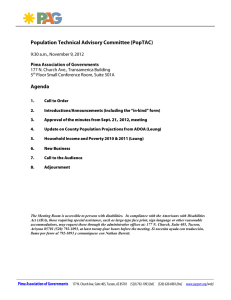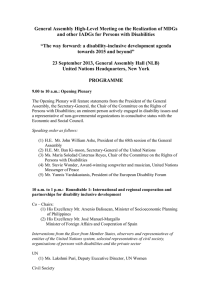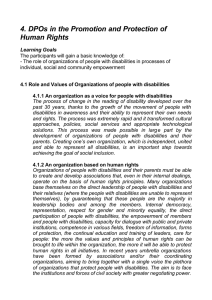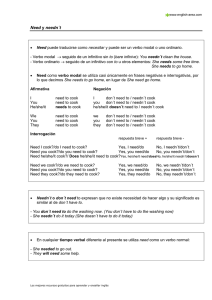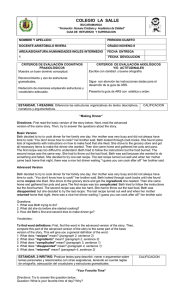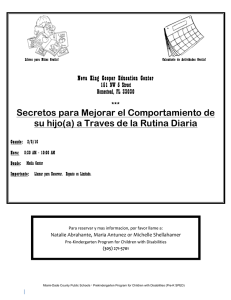FRIEND ET AL Co-Teaching. An Overview of the Past, a Glimpse at the Present, and Considerations for the Future
Anuncio
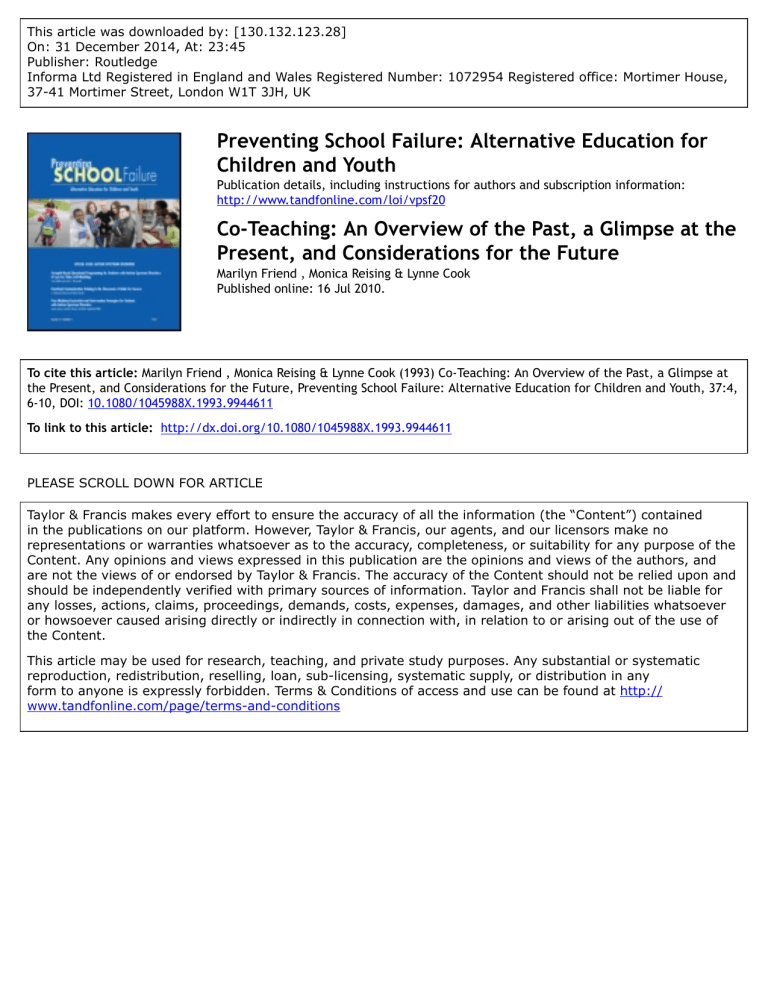
This article was downloaded by: [130.132.123.28] On: 31 December 2014, At: 23:45 Publisher: Routledge Informa Ltd Registered in England and Wales Registered Number: 1072954 Registered office: Mortimer House, 37-41 Mortimer Street, London W1T 3JH, UK Preventing School Failure: Alternative Education for Children and Youth Publication details, including instructions for authors and subscription information: http://www.tandfonline.com/loi/vpsf20 Co-Teaching: An Overview of the Past, a Glimpse at the Present, and Considerations for the Future Marilyn Friend , Monica Reising & Lynne Cook Published online: 16 Jul 2010. To cite this article: Marilyn Friend , Monica Reising & Lynne Cook (1993) Co-Teaching: An Overview of the Past, a Glimpse at the Present, and Considerations for the Future, Preventing School Failure: Alternative Education for Children and Youth, 37:4, 6-10, DOI: 10.1080/1045988X.1993.9944611 To link to this article: http://dx.doi.org/10.1080/1045988X.1993.9944611 PLEASE SCROLL DOWN FOR ARTICLE Taylor & Francis makes every effort to ensure the accuracy of all the information (the “Content”) contained in the publications on our platform. However, Taylor & Francis, our agents, and our licensors make no representations or warranties whatsoever as to the accuracy, completeness, or suitability for any purpose of the Content. Any opinions and views expressed in this publication are the opinions and views of the authors, and are not the views of or endorsed by Taylor & Francis. The accuracy of the Content should not be relied upon and should be independently verified with primary sources of information. Taylor and Francis shall not be liable for any losses, actions, claims, proceedings, demands, costs, expenses, damages, and other liabilities whatsoever or howsoever caused arising directly or indirectly in connection with, in relation to or arising out of the use of the Content. This article may be used for research, teaching, and private study purposes. Any substantial or systematic reproduction, redistribution, reselling, loan, sub-licensing, systematic supply, or distribution in any form to anyone is expressly forbidden. Terms & Conditions of access and use can be found at http:// www.tandfonline.com/page/terms-and-conditions A Downloaded by [] at 23:45 31 December 2014 Co-Teaching: An Ovewiew of the Past, a Glimpse at the Present, and Considerations for the Future MARILYN FRIEND, MONICA REISING, and LYNNE COOK s services for students with dis- abilities have moved toward new strategies for teaching in general education classrooms, educators have faced the challenge of creating appropriate service delivery models. Classroom teachers have stressed the importance of having support personnel physically present to assist in instructional activities (Giangreco, Dennis, Cloninger, Edelman, & Schattrnan, 1993). Special educators have voiced concern about appropriately meeting the needs of students with disabilities who no longer participate in pullout programs (Baker & Zigmond, 1990; Morsink & Lenk, 1992). One of the most rapidly emerging responses to such challenges is co-teaching. Co-teaching in special education is an instructional delivery approach in which a classroom teacher and a special education teacher (or other special services professional) share responsibility for planning, delivering, and evaluating instruction for a group of students, some of whom have exceptional needs (Friend & Cook, 1992b). Further, the instruction generally occurs within the context of a single classroom. In co-teaching, the teachers strive to create a classroom community in which all students are valued members, and they develop innovative teaching strategies that would not be possible if only one teacher was present. The purpose of this article is to form a foundation of understanding about co-teaching. To accomplish that goal, we will briefly review the development of co-teaching in public schools and describe the current status of coteaching. In addition, we will raise a number of issues and questions that will need to be addressed if co-teaching is to become a valid and widely accepted practice. The Development of Co-Teaching Marilyn Friend is an associate professor in special education, and Monica Reising is a doctoral student in special education, both at Indiana University-Purdue University at Indianapolis, and Lynne Cook is a professor of special education at California State University-Northridge, in Northridge. 6 PREVENTING SCHOOL FAILURE The roots for co-teaching as a special education service delivery option are found in the practice of team teaching among general education teachers. Team teaching first gained widespread popularity in the late 1950s when Trump (e.g., Trump, 1966) proposed reorganizing secondary schools so that teams of teachers shared responsibility for large-group presentations, followSummer 1993 Downloaded by [] at 23:45 31 December 2014 up sessions for groups of 12-15 students, and individualized study. His idea stemmed from a need to overcome the then-acute shortage of teachers, but also from his belief that such a model would enable schools to offer interdisciplinary and individualized instruction to students. During the 196Os, a number of variations of team teaching evolved. For example, in England, Warwick (1971) eliminated Trump’s discussion groups and instead proposed a model that comprised two components, a lecture to a large group of students followed by additional instruction in traditional class groups. Another variation of team teaching involved joint planning by teachers on interdisciplinary units but individual delivery of the instruction (Geen, 1985). The latter model was popular in open concept schools, particularly at the elementary level. In all of these models, a primary goal was to create educational environments that were student centered (EasterbySmith & Olve, 1984). By the early 197Os, team teaching had become a widespread practice. It occurred in both elementary and secondary schools (e.g., Crespin, 1971; Geen, 1985) in an entire range of subject matter (e.g., Meadows, 1973; Wood, 1972) and in many countries (Geen, 1985). However, because so many different approaches were called team teaching and because most reports on team teaching were simply descriptions of situation-specific programs, it is difficult to analyze whether team teaching was successful in terms of improving educational opportunities for students. What was apparent was that teachers found in team teaching an approach to their craft that was both challenging and rewarding. Recently, team teaching has been regaining popularity among general education teachers. It is a strategy often employed in middle schools and sometimes used in high schools. The rationale for these contemporary efforts is twofold: (a) to provide students with a more individualized and diversified learning experience and (b) to enable teachers to complement each other’s expertise while providing a mutual professional support system. VOl. 37,No.4 However, like the earlier team teaching Idol, Paolucci-Whitcomb, & Nevin, models, the current ones vary tremen- 1983) and collaboration (e.g., Friend & dously in the amount of shared plan- Cook, 19921). The several years of ning, the extent to which teachers ac- debate about definitions of these tually share a classroom during instruc- terms, appropriate uses of consultation tion, and the degree to which the as an intervention for students with disabilities, and the feasibility of inteaching is interdisciplinary. direct service delivery by special educaCo- Teaching in Special Education tion teachers resulted in clearer underEven before PL 94-142 became law, standings about some service delivery special educators were stressing the im- approaches. At the same time, howportance of partnerships between gen- ever, the debate diverted attention eral education and special education from the investigation and developteachers (Deno, 1973). Teaming be- ment of other service delivery apcame an integral component of main- proaches, including team teaching. streaming, and many authors discussed Most recently, educators have been how the teamwork between classroom distinguishing more carefully among teachers and special education teachers the many strategies for addressing stuwas critical for the success of main- dent needs in general education classstreaming. A variety of terms came in- rooms, and team teaching has begun to to use to describe such teaming, and grow in popularity. In addition, it has descriptions of it included different ap- been labeled cooperative teaching proaches to teacher collaboration in (Bauwens & Hourcade, 1991; Bauwens, jointly instructing students with dis- Hourcade, & Friend, 1989) or co-teaching abilities. However, team teaching was (Friend & Cook, 1992b) to distinguish it not a commonly acknowledged role for from the teams of general education special education and general educa- teachers who may share instructional tion teachers. For example, none of the responsibilities. authors of early texts on operating resource programs even mentioned team Current Practice teaching (e.g., Harris & Schutz, 1986; The momentum of the trend educatWiederholt, Hammill, & Brown, 1978, ing most students with disabilities in 1983), even though other alternative general education settings has provided roles (i.e., consultant) were thoroughly an impetus for educators to explore in discussed. greater detail the possibilities opened By the early 1980s, team teaching when a classroom teacher and special was identified as a strategy borrowed education teachers share instruction. from general education and applied to Based on our extensive work with teachspecial education as a means for mainers preparing to co-teach or evaluating streaming (Brandenberger & Womack, their co-teaching programs, and on a 1982; Garvar & Papania, 1982), but it feasibility study of co-teaching conwas heralded as an innovative apducted in Colorado (Adams, Cessna, & proach only just receiving attention Friend, 1993), the following appear to and requiring clear communication and careful negotiation among the be typical practices. teachers. In many ways, the potential of team teaching was overshadowed by Who Is Served other controversy and a confusion Most co-teaching occurs for students about service delivery. Specifically, the with mild disabilities, particularly rapidly growing need for approaches to learning disabilities, and it is most providing services for students with often a strategy of choice when a clusdisabilities in general education class- ter of students with special needs exists rooms was accompanied by recogni- in a particular grade level or class. That tion of the problems with traditional is, in elementary schools, co-teaching consultation as a special education may occur in the fourth grade because service approach function. These fac- there are 12 students with learning and tors prompted the introduction of the behavior problems in that grade, whereterms collaborative consultation (e.g., as it may not be used in the frst grade, PREVENTINGSCHOOL FAILURE 7 Downloaded by [] at 23:45 31 December 2014 where only two students have been identified as having disabilities. In a junior high school, co-teaching may be preferred when a special education science class or six or eight students can be combined with the general education science class that is taught during the same class period. Co-teaching is most often practiced in elementary schools and somewhat less so in middle schools. In junior high schools and high schools, co-teaching is not a widely accepted practice. How Co-Teaching Occurs Most co-teachers report that they establish a schedule for co-teaching and follow that schedule for either a semester or the entire school year. For example, in an elementary school, co-teaching may occur in Mr. Craft’s fifthgrade class each afternoon from 1:OO p.m. until 1:45 p.m. for social studies. In a high school, Ms. Limbaugh and Ms. Shane might co-teach daily for junior English. It should be noted that despite teachers’ apparent preferences for this scheduled approach to coteaching, other approaches are also possible. For example, in some schools teachers co-teach only when the difficulty of the content, the needs of the students, or the types of activities planned make it an attractive alternative. In other schools, co-teaching is scheduled, but not daily. The amount of co-teaching scheduled for any classroom depends on the number of students with disabilities and the intensity of their needs. Classroom Structures Co-teachers are approaching their shared instruction by employing a range of options. In some classes, the teachers take turns; one leads wholeclass groups while the other observes students or quietly offers assistance to students. In others, teachers divide groups of students into heterogeneous groups and then create parallel instructional groups or classroom teaching stations. In yet others, the two teachers share an active role, jointly sharing a discussion, demonstrating a historical event through an impromptu skit, or modeling skills such as notetaking. An outline of these various structures is provided in Table 1. 8 PREVENTING SCHOOL FAILURE When the two teachers truly perceive (Harris et al., 1987) provided positive that they are equal partners in co- data on a high school program. Pasteaching, they report it as a tremendous- saglia (1992) discussed the complexities ly energizing experience. However, two of co-teaching but also shared her exrelated problems are relatively common: periences with the rewards of this type First, in some co-taught classes the fun- of collaborating. Others reported simidamental classroom structure, instruc- lar experiences (e.g., Adamson, Mattional format, and leadership do not thews, & Schuler, 1990). change. That is, the classroom teacher may assume that the special educator’s Considerations for the Future presence should not have any impact on Whether co-teaching will become a the class. Second, in such situations, the widely accepted practice in schools respecial education teacher typically funcmains to be seen. In part, this will detions more like a paraprofessional or stupend on the resolution of several crudent teacher in the class. Problems such cial issues. as these may be the result of too little planning prior to co-teaching. They may also occur because of a sense of losing in- Resources In this era of economic constraints structional control. and shrinking school resources, any Effectiveness discussion about the future of coMuch of the information currently teaching must begin with an acknowlavailable about co-teaching is anec- edgment of its costs. First, it is expendotal. For example, Friend and Cook sive for two qualified professionals to (1992b) interviewed a co-teaching share a group of students not much team; the teachers reported that co- larger than the group the classroom teaching was effective in positively af- teacher taught alone. Second, in order fecting student achievement and self- for co-teaching to be used effectively, concept and that it enabled them to ex- teachers must have opportunities to periment with a wide variety of teach- plan together and to evaluate their ing techniques. White and White shared instruction. This, of course, re(1992) reported similar positive experi- quires even more time. Third, coences in a middle school co-teaching teaching requires an increase in the model, and Harris and her colleagues resource of space allocation. TABLE 1 Co-Teaching Structures One teach, one assist Both teachers are present, but one-often the general education teacher-takes the lead. The other teacher observes or “drifts” around the room assisting students. Station teaching Teachers divide the content to be delivered, and each takes responsibility for part of it. Some students may also work independently. Eventually all students participate in all “stations.” Parallel teaching Teachers jointly plan instruction, but each delivers it to half of the class group. Alternative teaching One teacher works with a small group of students to pre-teach, re-teach, supplement, or enrich while the other teacher instructs the large group. Team teaching Both teachers share the instruction of students. They may take turns leading a discussion, demonstrate concepts or learning strategies, and model a p propriate question-asking or conflict behavior. Note. Information in this figure is adapted from Cook & Friend (1993),Co-teach! Strategies for Creating Successful Teaching learns (in preparation). Summer 1993 Downloaded by [] at 23:45 31 December 2014 To respond to the cost issue, educators must first ensure that the instruction that occurs in a co-taught classroom is quantitatively and qualitatively different from that offered in other classrooms. That is, an observer visiting a co-taught class should see the teachers creatively dividing students for small-group work, modeling question-asking and role-playing, and otherwise using both teachers’ talents to the maximum extent. What cannot be justified is a classroom tht looks just like it did with one teacher except that now there are two teachers, one of whom is “helping out” or acting as an instructional assistant. The matter of planning time is another resource issue demanding consideration. Co-teachers explain that one of the lessons they must learn is to use their time wisely (Adams, Cessna, & Friend, 1993). They change the typical teacher interaction pattern by intentionally discussing their shared teaching as the first topic of conversation rather than first discussing the day’s events or other personal or school topics. Social conversation becomes a decidedly less time-consuming part of interactions. Further, teachers who co-teach may find that an occasional block of time (e.g., a half-day once each grading quarter) is sufficient for long-range planning and that other briefer planning periods can be created from existing planning time. The matter of space for co-teaching is one typically beyond the control of school professionals. In some schools, classrooms are large and the addition of a few extra students or increased activity such as one that accompanies multiple learning groups can easily be accommodated. In others, however, the primary criterion for arranging furniture is to leave enough room for an aisle. The former schools may find coteaching a much more attractive alternative than the latter. In sum, the cost of co-teaching must be weighed against its benefits. The amount of co-teaching in any special education program should be based on a simultaneous analysis of co-teaching’s priority to school staff, benefit to students, and feasibility given other facVol. 37,No. 4 tors such as the availability of the needed which they are to engage and the ways in which they are supervised. These time and space. factors raise several questions: Is coParticipants teaching possible when one teacher is A second group of issues concerns certified and employed as a teacher and the staff members who might best en- the other is a paraprofessional? What gage in co-teaching and the coordina- is the impact of this on parity in the tion of their efforts. In the past several classroom? If paraprofessionals want years, co-teaching has been proposed to co-teach, to what extent is it approas a role for special education teachers priate to give them full instructional of students with mild and severe disa- responsibility for a topic or group of bilities, speech/language therapists, students? Is it ethical to ask an indiremedial reading teachers, occupa- vidual, even a willing one, to carry the tional and physical therapists, and psy- responsibilities of a teacher without rechologists and counselors. For each of ceiving appropriate compensation? these groups, co-teaching offers the And finally, at some schools, profespotential for incorporating instruction sionals are seemingly deciding to “cash into the natural context of the class- in” a special educator for two or three room, but what about the impact of paraprofessionals. Is the resulting inthis on the classroom teacher? Some crease in people available to assist in teachers find that if they have consider- classes an appropriate substitution for able diversity in their classrooms, a pa- the professional judgment and decirade of professional follows. Add to sionmaking skill of a special education this the potential of having student teacher? This raises another ethical teachers, parent volunteers, tutors, question concerning the appropriate and/or other assistants in the class- provision of services to students with room, and the matter of preserving the disabilities. Attempting to provide simple anintegrity of the classroom community swers to these complex questions about becomes critical. To avoid the problems that may be paraprofessionals and co-teaching caused by several adults working in a would be presumptuous. However, we single class, teachers and other school urge professionals developing coprofessionals should openly discuss teaching programs to consider them how to efficiently manage their co- carefully. teaching program. Sometimes this includes sharing responsibility for the Implementation day-to-day instruction of students with A third area of consideration for codifferent needs. For example, a speech- teaching is implementation, and again, language therapist might provide in- a number of questions have not yet struction to students with learning been addressed. One fundamental condisabilities in a first-grade classroom, cern involves students. To date, little thus freeing the teacher of students information is available t o demonwith learning disabilities to work in strate that co-teaching is an effective another class. The professionals keep strategy for any particular group of each other informed about progress students with disabilities, or for these and problems of the students in their students as a whole. A few studies (e.g., Harris et al., 1987) have reported respective co-taught classes. The use of paraprofessionals for co- that students prefer a co-taught class, teaching also needs mention. In some but far more detailed information is locations, paraprofessionals are fully needed to make informed decisions certified teachers who are confortable about committing t o co-teaching as a taking significant responsibility for in- service delivery approach. It might be struction. In other areas, parapro- that students with mild learning or fessionals may have little or no educa- behavior disabilities will benefit more tional training or experiences. In both from co-teaching than from resource instances, paraprofessionals usually programs, consultation, or other apare poorly paid and limited by position proaches. The same may be true for description in the types of activities in students with moderate or severe disaPREVENTINGSCHOOL FAILURE 9 Downloaded by [] at 23:45 31 December 2014 bilities. At this point, there simply are not enough data available to provide valid information concerning students. And, it should be noted that the same is true for the impact of co-teaching on students without disabilities. Extensive research is needed on the impact of coteaching on students. Another implementation matter is one of quantity. How much co-teaching is enough? Should teachers share a time slot or class every day? If coteachers share instruction only periodically or only on specific units, are the benefits to students the same as when co-teaching is daily? Can this approach be justified in terms of meeting the requirements of IEPs? On the other hand, if teachers are locked into specific co-teaching schedules, do they perceive that they are giving up the freedom to be flexible in their teaching? And are services then unavailable to other students and classrooms? One additional implementation matter is related to the school context. Coteaching often has an impact on many, if not all, aspects of a school’s scheduling. For example, in a high school, if a biology class is co-taught it may be that a disproportionately high number of students with disabilities are placed in that class. Informal and inappropriate tracking may be the result. In an elementary school, many teachers may want co-teaching to occur during a language arts period. If so, some teachers may have to schedule language arts activities for late in the afternoon instead of in the morning so that the special education teacher can accommodate the requests. In any school, if coteachers need shared planning time, other teachers may not receive the planning period to which they are accustomed. Conclusion Co-teaching holds great promise as one approach for supporting students 10 PREVENTING SCHOOL FAILURE with disabilities in general education settings. It has past and present support in team teaching, and it is consistent with the increasing emphasis in schools on collaboration (Friend & Cook, 1992a). Teachers report that students in their co-taught classes perceive that someone is always available to assist them and that everyone receives special help. Teachers also share that they experience a sense of professional renewal when they co-teach. However, co-teaching is not a panacea. It is labor and time intensive and requires a high level of commitment and a high degree of coordination. The articles in this special issue demonstrate how co-teaching can occur. However, whether co-teaching will be an integral part of schools of the future or a fad that rapidly fades is not yet clear. Until the knowledge base about co-teaching increases, we recommend that it be explored optimistically but with appropriate caution. Council for Exceptional Children. (ERIC Document Reproduction Service No. ED 074678) Easterby-Smith, M., dr Olve, N. G. (1984). Team teaching: Making management education more student-centered? Management Education and Development, I S , 221-236. Friend, M., & Cook, L. (199%). Interactions: Collaboration skills for school professionals. White Plains, N Y : Longman. Friend, M., & Cook, L. (1992b). The new mainstreaming: How it really works. Instructors. 101(7), 30-36. Garvar, A., & Papanla, A. (1982). Team teaching: It works for the student. Academic Therapy, 18(2), 191-196. Geen, A. G. (1985). Team teaching in the secondary schools of England and Wales. Educational Review, 37, 29-38. Giangreco, M. D., Dennis, R . . Cloninger, C., Edelrnan, S., & Schattman, R. (1993). “I’ve counted Jon”: Transformational experiences teachers educating students with disabilities. Exceptional Children, 59, 359-372. Harris, W. J., & Schutz, P. N. B. (1986). The special education resource program: Rationale and implementation. Columbus, OH: Merrill. Harris, K . C., Harvey, P., Garcia, L., Innes, D., Lynn, P., Munoz, D., Sexton, K., &Stoica, R. (1987). Meeting the needs of special high school students in regular education classrooms, Teacher Education and Special Education, 10, 143-152. Idol, L., Paolucci-Whitcomb, P., & Nevin, A . (1986). Collaborative consultation. Rockville, REFERENCES MD: Aspen. Adams, L. Cessna, K . , & Friend, M. (1993). Meadows, B. J . (1973). Three-sided method proves effective in biology teaching. American A feasibility study of co-teaching in Colorado Biology Teacher, 35, 291-292. (unpublished manuscript, Colorado DepartMorsink, C. V., & Lenk, L. L. (1992). The ment of Education). delivery of special education programs and Adamson, D. R., Matthews, P., & Schuler, J . services: Remedial and Special Education, (1990). Five ways to bridge the resource room13(6), 33-43. to-regular classroom gap. Teaching Exceptional Children, 22(2), 74-77. Passaglia, C. (1992). Hey! This inclusion “stuff” ain’t easy! Co-teaching Network Baker, J . M.. & Zigmond, N. (1990). Are reguNews, 1(2), 1-2. lar education classes equipped to accommodate students with learning disabilities? Ex- Trump, J . L. (1966). Secondary education tomorrow: Four imperatives for improvement. ceptional Children, 56, 515-526. NASSP Bulletin, 50(309), 87-95. Bauwens, J., & Hourcade, J. J. (1991). Making co-teaching a mainstreaming strategy. Pre- Warwick. D. (1971). Team teaching, London: University of London. venting School Failure, 35(4), 19-24. Bauwens, J . , Hourcade, J. J., & Friend, M. White, A. E., & White, L. L. (1992). A collaborative model for students with mild dis(1989). Cooperative teaching: A model for abilities in middle schools. Focus on Excepgeneral and special education integration. tional Children, 24(9), 1-10. Remedial and Special Education, 10(2), 17-22. Brandenberger, J., & Womack, S. T. (1982). Wiederholt, J. L., Hammill, D. D., & Brown, V . L. (1978). The resource teacher: A guide to Division of labor in a special team teaching effective practices. Boston: Allyn & Bacon. situation. Clearinghouse, 55( 5), 229-230. Cook, L., & Friend, M. (1993). Co-teach! Wiederholt, J . L., Hammill, D. D., & Brown, V. L. (1983). The resource teacher: A guide to Straregies for creating successful teaching effective practices (2nd ed.). Boston: Allyn & reams (In preparation). Bacon. Crespin, B. J . (1971). Means of facilitating Wood, G. E. (1972). Provided-English for preeducation sought. Education, 92(2), 36-37. vocational students. English Journal, 61, Deno, E. N. (Ed.). (1973). Instructional alter385-388. natives for exceptional children. Reston, VA: Summer 1993
